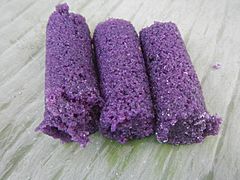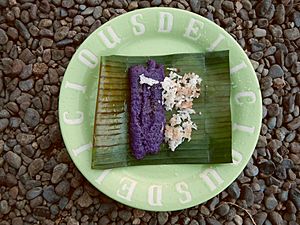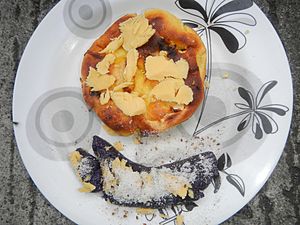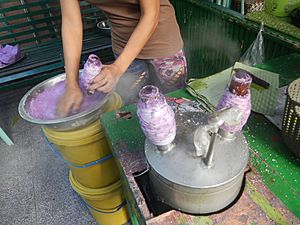Puto bumbóng facts for kids
 |
|
| Alternative names | Puto bombong |
|---|---|
| Course | Dessert |
| Place of origin | Philippines |
| Serving temperature | Room temperature, hot |
| Main ingredients | Pirurutong glutinous rice, white glutinous rice, muscovado, grated coconut, butter/margarine, sesame seeds |
| Variations | puto |
| Similar dishes | kue putu, putu bambu, puttu |
Puto bumbóng is a yummy purple rice cake from the Philippines. It's special because it's cooked inside bamboo tubes using steam! People usually enjoy this sweet treat during the Christmas season. It's a kind of puto, which means "steamed rice cake."
Contents
What's in a Name?
The name Puto bumbóng comes from two Tagalog words. Puto means "steamed rice cakes." Bumbóng or bombong means "bamboo tube." So, it's a "steamed rice cake from a bamboo tube!" Sometimes, people mistakenly spell it as puto bungbong or puto bongbong.
How Puto Bumbóng is Made
Puto bumbóng is made from a special kind of glutinous rice. This rice is called pirurutong. It has a deep purple or almost black color. In some places, it's also called tapol. This purple rice is mixed with more white glutinous rice. White glutinous rice is known as malagkit or malagkit sungsong in Tagalog. In other areas, it's called pilit. Sometimes, regular white rice is used instead of malagkit. This makes the dish a little less chewy.
To prepare the rice, it's soaked in water overnight. Traditionally, it's soaked in salted water. This soaking gives the rice a slightly sour taste. After soaking, the rice is drained. Then, it's packed tightly into bamboo tubes. These tubes are then steamed until the rice cake is cooked.
The inside of the bamboo tubes is usually greased. Long ago, coconut oil was used. Today, butter or margarine are more common. The rice is usually cooked as whole grains. But some people grind the rice before or after it's soaked.
Serving Your Puto Bumbóng
Once cooked, the Puto bumbóng comes out as a cylindrical (tube-shaped) rice cake. It's often served on banana leaves. More butter or margarine is spread on top. Then, it's sprinkled with muscovado sugar. This is a type of brown sugar. Sometimes, plain brown sugar or white sugar is used. Grated coconut is also a common topping. Some people even add sesame seeds.
Modern toppings can be very creative! You might find Puto bumbóng with condensed milk instead of sugar. Some even add cheese or leche flan (a type of custard).
Puto Bumbóng and Christmas
In the Philippines, most people are Catholic. Puto bumbóng is a very popular snack or breakfast during the Christmas season. It's especially linked to Simbang Gabi. This is a special nine-day church service before Christmas. You'll often see stalls selling Puto bumbóng and other snacks outside churches during this time.
Different Kinds of Puto Bumbóng
Today, some Puto bumbóng is made using metal cylinders or regular food steamers. These versions might be shaped into small balls or long, narrow tubes. They can look a bit like suman, another Filipino rice cake.
The special pirurutong rice is becoming rare. So, some modern versions use purple food coloring instead. Others use purple yam (called ube) flour. However, many people feel these versions are not the real thing.
Restaurants sometimes get creative with Puto bumbóng. You might find it as an ice cream flavor, in pancakes, cakes, or even in empanadas (savory pastries).
A similar dish is putong sulot. It comes from the provinces of Batangas and Pampanga. This version uses white glutinous rice. Unlike Puto bumbóng, putong sulot is available all year round.
Similar Dishes Around the World
Puto bumbóng has relatives in other countries!
Southeast Asian Cousins
In Indonesia, Malaysia, and other parts of Maritime Southeast Asia, there are similar dishes. They are called kue putu or putu bambu. These dishes are usually green. This color comes from pandan leaves, which are used for flavor.
South Asian Relatives
In India (especially in Kerala, Tamil Nadu, and Karnataka) and Sri Lanka, there's a dish called puttu or pittu. This dish is also cooked in bamboo tubes. But it's usually a savory dish, not a sweet dessert.
Even though these dishes are different, they all share one cool thing: they are cooked in bamboo tubes!




